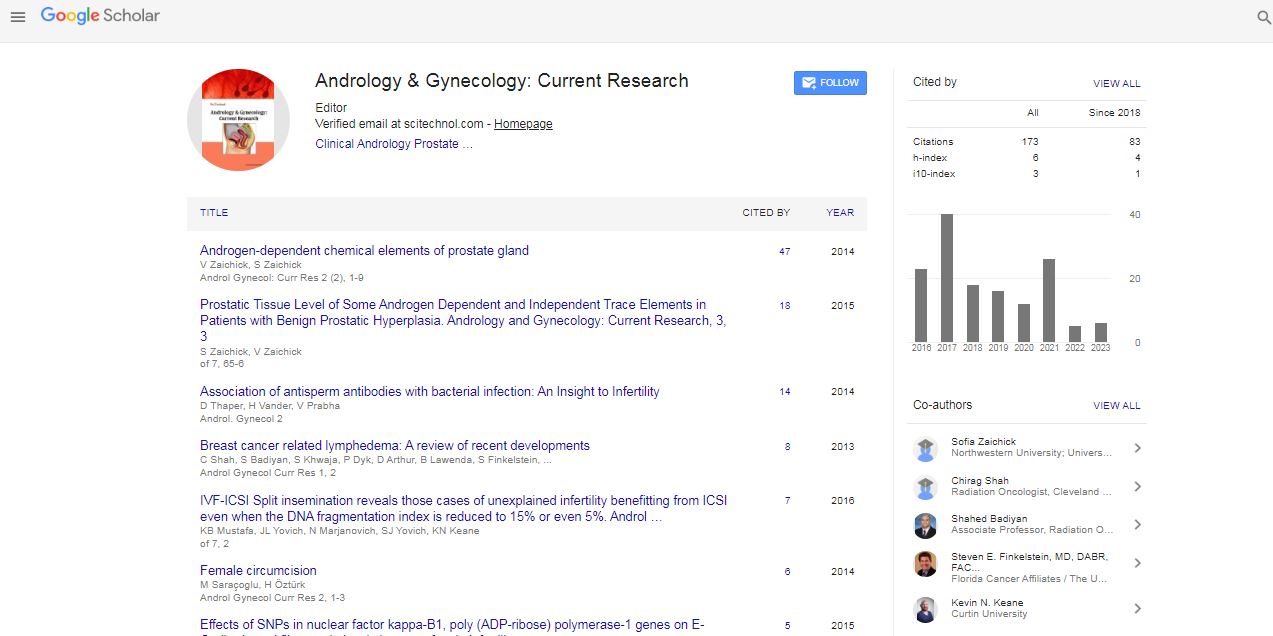Editorial, Androl Gynecol Curr Res Vol: 13 Issue: 1
Advances in Male Infertility Diagnosis and Treatment: A Contemporary Overview
Ashok Agarwal*
Department of Biotechnology, Bharathiar University, India
- *Corresponding Author:
- Ashok Agarwal
Department of Biotechnology, Bharathiar University, India
E-mail: Ashokagarwal@yahoo.com
Received: 07-Mar-2025, Manuscript No. AGCR-25-168374, Editor assigned: 08-Mar-2025, PreQC No. AGCR-25-168374 (PQ), Reviewed: 15-Mar-2025, QC No. AGCR-25-168374, Revised: 22-Mar-2025, Manuscript No. AGCR-25-168374 (R), Published: 28-Mar-2025, DOI:10.4172/2325-9620.1000341
Citation: Ashok A (2025) Advances in Male Infertility Diagnosis and Treatment: A Contemporary Overview. Androl Gynecol 13:1.
Copyright: © 2025 Ashok A. This is an open-access article distributed under the terms of the Creative Commons Attribution License, which permits unrestricted use, distribution and reproduction in any medium, provided the original author and source are credited.
Abstract
Introduction
Male infertility is a significant yet often under-recognized contributor to couple infertility, accounting for nearly 40-50% of cases worldwide. Traditionally, the diagnosis and treatment of male infertility have relied on basic semen analysis and limited therapeutic options. However, in recent years, rapid advances in diagnostic technologies and treatment modalities have transformed the landscape of male reproductive medicine. This editorial aims to provide a contemporary overview of the latest advancements in male infertility diagnosis and treatment, highlighting key developments and future directions [1]-3].
Advances in Diagnostic Approaches
- Enhanced Semen Analysis and Sperm Function Testing
While conventional semen analysis remains the cornerstone of male fertility assessment, its limitations in predicting fertility potential have become increasingly evident. Newer techniques such as sperm DNA fragmentation assays, oxidative stress measurements, and advanced motility assessments (e.g., computer-assisted sperm analysis - CASA) provide deeper insights into sperm quality and functionality. These methods help identify subtle sperm defects that are not captured by routine analyses.
- Genetic and Molecular Testing
Recent developments in molecular diagnostics have facilitated the identification of genetic abnormalities contributing to male infertility. Techniques such as next-generation sequencing (NGS) allow for comprehensive screening of gene mutations and deletions, including Y-chromosome microdeletions and CFTR gene mutations. Epigenetic markers and microRNA profiles are also being investigated as potential diagnostic and prognostic tools, offering a window into sperm health at the molecular level.
- Imaging Technologies
High-resolution scrotal ultrasound and magnetic resonance imaging (MRI) provide non-invasive visualization of testicular and reproductive tract anatomy. These imaging tools aid in the detection of varicocele, testicular tumours, and obstructive lesions, guiding clinical decision-making.
Innovations in Treatment Modalities
- Medical Therapies
The development of targeted pharmacologic treatments addressing underlying causes of male infertility, such as hormonal imbalances and oxidative stress, has gained momentum. Selective estrogen receptor modulators (SERMs), gonadotropins, and antioxidants are increasingly utilized to optimize spermatogenesis and sperm quality.
- Surgical Interventions
Microsurgical techniques have revolutionized the management of conditions like varicocele and obstructive azoospermia. Procedures such as microsurgical varicocelectomy and vasoepididymostomy improve fertility outcomes while minimizing complications.
- Assisted Reproductive Technologies (ART)
ART remains a mainstay for severe male factor infertility. Innovations include intracytoplasmic sperm injection (ICSI), which allows fertilization with a single viable sperm, and advanced sperm retrieval techniques like microdissection testicular sperm extraction (micro-TESE), improving success rates in azoospermic patients.
- Emerging Therapies
Stem cell therapy and gene editing hold promise for the future treatment of male infertility. Preliminary studies suggest potential for regenerating spermatogenic cells and correcting genetic defects, although these approaches remain experimental.
Challenges and Future Perspectives
Despite these advances, challenges remain in standardizing diagnostic protocols and personalizing treatment strategies. Additionally, psychosocial aspects of male infertility are often overlooked and require integrated care models. Future research should focus on validating novel biomarkers, expanding therapeutic options, and improving patient-centered outcomes [4], 5].
Conclusion
The field of male infertility has witnessed significant progress in diagnosis and treatment, driven by technological innovations and growing understanding of male reproductive biology. Integrating these advancements into clinical practice holds promise to improve fertility outcomes and quality of life for affected men and couples. Continued research, multidisciplinary collaboration, and patient education are essential to realize the full potential of these emerging tools and therapies.
References
- Mamikonyan VR, Pivin EA, Krakhmaleva DA. Mechanisms of corneal neovascularization and modern options for its suppression. Vestn Oftalmo. 2016; 132(4):81-87.
- Gaigalaite V, Dementaviciene J, Vilimas A, Kalibatiene D. Association between the posterior part of the circle of Willis and vertebral artery hypoplasia. PLoS ONE. 2019; 14(9): e0213-226.
- Anri S, Masayoshi O, Shigeru H. Glomerular Neovascularization in Nondiabetic Renal Allograft Is Associated with Calcineurin Inhibitor Toxicity. Nephron. 2020; 144 Suppl 1:37-42.
- Mujagic S, Kozic D, Huseinagic H, Smajlovic D. Symmetry, asymmetry and hypoplasia of intracranial internal carotid artery on magnetic resonance angiography. Acta Med Acad. 2016; 45:1- 9.
- Rusu MC, Vrapclu AD, Lazar M. A rare variant of accessory cerebral artery. Surg Radiol Anat. 2023; 45(5):523-526.
 Spanish
Spanish  Chinese
Chinese  Russian
Russian  German
German  French
French  Japanese
Japanese  Portuguese
Portuguese  Hindi
Hindi 


